A quality gallery marketer published a podcast I listened to just this past week. The teaser? ‘Three things not to talk about (if you want to sell your art)’. Here’s the short version: never talk about politics, religion or sports. This guy is good, and I respect his advice; but the funny part is, I had just that morning posted an opinion piece on my personal facebook page. I decided to leave it there, as there is so much mud in the waters now politically, and the op-ed writer I shared was shining some light on a certain subject. It didn’t take long before another artist friend of mine (who sells very well) posted an alternate view to the article I liked under mine. I appreciated her viewpoint; it gave some important info. But haunting me was the echo of several who’ve instructed me “don’t get political” so, I did the more sober thing and deleted the entire post. Politics has shown its complete unreliability, and so I’ll stay mum on that score.
I’m reminded of advice given my husband and I years ago. We were in our young 20’s, and taking our summer job boss out to dinner to thank him. He was a pleasant man, maybe several decades older than us. We were from the era of campus political demonstrations and new in our spiritual convictions. To us: ‘if you care about someone, you talk about what is most important to you.’ He tried to give us advice (which we did not take): “There are two things you never talk about: religion or politics”. People said something like that a lot in the 1950’s. I remember quietly imagining how boring if conversations could never wrestle with such things.
Now I’m older than that boss was then. Now I am learning new tricks and living in a very different, even more divisive time. And one of those taboo subjects (according the gallery marketer) is what moves me to work! I certainly will talk about what moves my work and my every aim. Life has exposed politics as simply the maneuvers and manipulations of men on other men. And religion of every stripe is simply the same attempted upward. What moves me however is how the Creator of each and every man and woman is still speaking. He enters in.
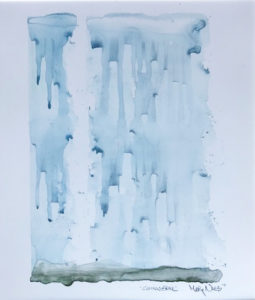 The advantage I have doing art is that I can “tell it slant” as Emily Dickinson used to say. There is no muzzle on when the work sings with beauty on its own. Makoto Fujimura explains it: “Art is an inherently hopeful act, an act that echoes the creativity of the Creator. Every time an architect imagines a new building, an artist envisions that first stroke of a brush on a white canvas, a poet seeks a resonant sound in words, or a choreographer weaves a pause in layers of movements, that act is done in hope; the creator reaches out in hope to call the world into that creation.” –Refractions (NavPress, 2009), 68.
The advantage I have doing art is that I can “tell it slant” as Emily Dickinson used to say. There is no muzzle on when the work sings with beauty on its own. Makoto Fujimura explains it: “Art is an inherently hopeful act, an act that echoes the creativity of the Creator. Every time an architect imagines a new building, an artist envisions that first stroke of a brush on a white canvas, a poet seeks a resonant sound in words, or a choreographer weaves a pause in layers of movements, that act is done in hope; the creator reaches out in hope to call the world into that creation.” –Refractions (NavPress, 2009), 68.
No deletions have to be considered when the work gently vibrates into even the harshest of times. Art speaks, and best when it is responding to the original initiator. It beckons and invites. And you can walk away without feeling like you’ve been sold something you didn’t want to buy.
The artists are the ones who may be the best at talking now, for as C.S. Lewis said, they are the ones who can “steal past those watchful dragons”.
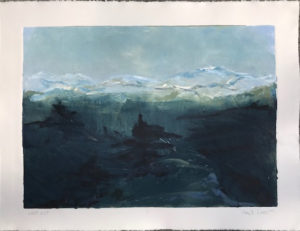 The fields are white, the horizon beckons and we’re keeping our trekking boots on. Some 48 years ago, I heard theologian Dr. Joseph Dillow explain the patterns in the ridges and the valleys of Isaiah’s prophetic masterpiece. It was like being in a biblical glider over peaks and valleys in the histories of nations. The prophet, viewing from hundreds of years before Jesus, saw with distinct clarity what was coming. To a young design student, this uber-view was mind-altering stuff. And we are standing in the midst of what Isaiah further predicted. To quote a secular seer “so let us not speak falsely now, the hour is getting late”*. We know the King is coming — we’ll not lag here in retreat.
The fields are white, the horizon beckons and we’re keeping our trekking boots on. Some 48 years ago, I heard theologian Dr. Joseph Dillow explain the patterns in the ridges and the valleys of Isaiah’s prophetic masterpiece. It was like being in a biblical glider over peaks and valleys in the histories of nations. The prophet, viewing from hundreds of years before Jesus, saw with distinct clarity what was coming. To a young design student, this uber-view was mind-altering stuff. And we are standing in the midst of what Isaiah further predicted. To quote a secular seer “so let us not speak falsely now, the hour is getting late”*. We know the King is coming — we’ll not lag here in retreat.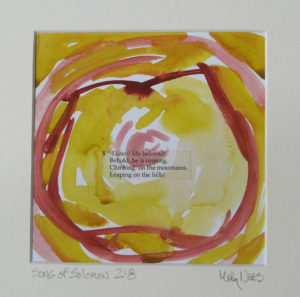 The little ones around us this week are learning to wait. “Can we have Daddy’s cake now that you have come in the door?” “Nini, can I play (bang) on the piano now?!’ “Are you done resting?” “Are you awake?” “Can you tell that story again Pop? Let’s go back in my room and pretend you’re putting me to bed! Tell it to me again, Pop!”
The little ones around us this week are learning to wait. “Can we have Daddy’s cake now that you have come in the door?” “Nini, can I play (bang) on the piano now?!’ “Are you done resting?” “Are you awake?” “Can you tell that story again Pop? Let’s go back in my room and pretend you’re putting me to bed! Tell it to me again, Pop!” We’re preparing. And since visuals speak so powerfully to me, I painted a symbol on our front door. Similar to any other sign, one has to stop here and think. Strange things require some investigation to understand what’s really going on. People who know me already are primed for surprises. My engineer looked tentatively, bemused at the gleam in my eyes as to what I’d done now. One of my daughters just smiled at her weird mom. I got out some red paint, and researched which branches in my backyard would more closely resemble the hyssop used in Exodus. When the Israelites were told to paint blood on the lintel and posts of their doors right before their great rescue it must have been a truly weird act of faith. But the
We’re preparing. And since visuals speak so powerfully to me, I painted a symbol on our front door. Similar to any other sign, one has to stop here and think. Strange things require some investigation to understand what’s really going on. People who know me already are primed for surprises. My engineer looked tentatively, bemused at the gleam in my eyes as to what I’d done now. One of my daughters just smiled at her weird mom. I got out some red paint, and researched which branches in my backyard would more closely resemble the hyssop used in Exodus. When the Israelites were told to paint blood on the lintel and posts of their doors right before their great rescue it must have been a truly weird act of faith. But the  Back to earth, there is something in Job’s proclamation that does ring true for me. I have ideas and ambition, but unless my hands get busy, unless I have the courage to learn from the messes, and unless I manifest it somewhere. I have nothin’. Yesterday I picked up from the post office a piece which has been all over the country in a 3 year traveling show:
Back to earth, there is something in Job’s proclamation that does ring true for me. I have ideas and ambition, but unless my hands get busy, unless I have the courage to learn from the messes, and unless I manifest it somewhere. I have nothin’. Yesterday I picked up from the post office a piece which has been all over the country in a 3 year traveling show: 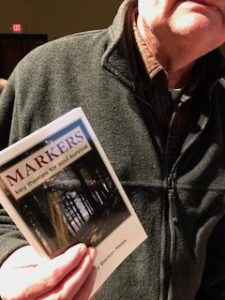
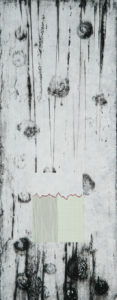 I showed them some pieces like this one, “Time and Mercy” where the chaos is falling down all around the inner life. But there on the inside is the mark of a heartbeat, and the recording of time. There’s a history that is undeniable, part of the fabric that cannot be changed. There’s a span ahead yet unknown. But in this present moment I can breathe and pause. This is the potential moment where beauty is born. For right now I can lift my head because the evidence of love is still shining through for those who are eager for it.
I showed them some pieces like this one, “Time and Mercy” where the chaos is falling down all around the inner life. But there on the inside is the mark of a heartbeat, and the recording of time. There’s a history that is undeniable, part of the fabric that cannot be changed. There’s a span ahead yet unknown. But in this present moment I can breathe and pause. This is the potential moment where beauty is born. For right now I can lift my head because the evidence of love is still shining through for those who are eager for it. A seasoned pro said this last fall in my hearing and it struck me: SO TRUE: “it’s simple, but it’s not easy”! This could be a mantra for continued practice in any discipline worth pursuing. The key things to know are basic, evident, clear from the ground up. They are simple. Jesus boiled all the law and the prophets down to just two ideas. Nodding our heads, we’re all pleased with ourselves until we actually try to do those two things.
A seasoned pro said this last fall in my hearing and it struck me: SO TRUE: “it’s simple, but it’s not easy”! This could be a mantra for continued practice in any discipline worth pursuing. The key things to know are basic, evident, clear from the ground up. They are simple. Jesus boiled all the law and the prophets down to just two ideas. Nodding our heads, we’re all pleased with ourselves until we actually try to do those two things.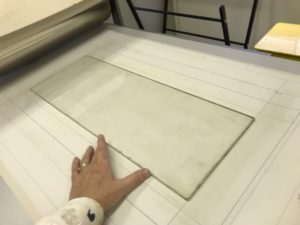 Stick with the simple things and then start moving out creatively! Easy Peasy. It’s getting to the finish that’s the tough part. We know what to do, we imagine so easily! But the sublime result takes a whole lot more effort than we romantics ever imagined!
Stick with the simple things and then start moving out creatively! Easy Peasy. It’s getting to the finish that’s the tough part. We know what to do, we imagine so easily! But the sublime result takes a whole lot more effort than we romantics ever imagined!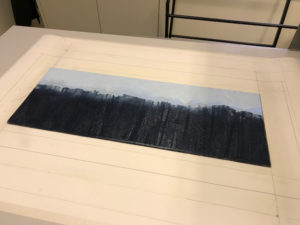 And so, I consider the basics again, chalk it up to “at least I tried” and “I learned something today that will feed the next one”… So, there’s nothing to show here today but some starts, and some working resolve.
And so, I consider the basics again, chalk it up to “at least I tried” and “I learned something today that will feed the next one”… So, there’s nothing to show here today but some starts, and some working resolve. I slammed my computer closed this morning. The click-bait headlines have me so wearied, sickened. You can point fingers, but we’re all in this thing together. So, I did the next thing in my little life. I went to the grocery store. I had to do this anyway today, but I got there early and started to relish the simple tasks of handling and selecting real live things that will make a difference in our well being this week. I got to choose. I chose to enjoy the steps, the colors, the kindness of the produce man. I don’t think I have ever enjoyed a grocery trip more! I came home with several bags of supplies, and arranged some on my counter like a Dutch still life. Art is not imitating life here. Real life was already happening. You could rather say Life is imitating art of a sort. This is some of the gleanings I’ll use up this week.
I slammed my computer closed this morning. The click-bait headlines have me so wearied, sickened. You can point fingers, but we’re all in this thing together. So, I did the next thing in my little life. I went to the grocery store. I had to do this anyway today, but I got there early and started to relish the simple tasks of handling and selecting real live things that will make a difference in our well being this week. I got to choose. I chose to enjoy the steps, the colors, the kindness of the produce man. I don’t think I have ever enjoyed a grocery trip more! I came home with several bags of supplies, and arranged some on my counter like a Dutch still life. Art is not imitating life here. Real life was already happening. You could rather say Life is imitating art of a sort. This is some of the gleanings I’ll use up this week.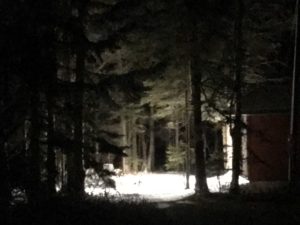 The last image of the year is one my husband shot out our tiny cabin window. The garage light was on, and all was still on the darkest night of the year in the Northland where my grandparents settled long ago. The frigid air, the wild vunerability of this backwater place and the mystery of light penetrating, so surgically into enveloping darkness was what moved us both with this digital glimpse. This is only a token, an illustration, of a sublime reality. I’m thinking of a baby born on another dark night, in another backwater place, where light burst forth into their precarious situation. John’s gospel says at the beginning “light shines (present tense) into the darkness, and the darkness did not comprehend it.” John 1:5
The last image of the year is one my husband shot out our tiny cabin window. The garage light was on, and all was still on the darkest night of the year in the Northland where my grandparents settled long ago. The frigid air, the wild vunerability of this backwater place and the mystery of light penetrating, so surgically into enveloping darkness was what moved us both with this digital glimpse. This is only a token, an illustration, of a sublime reality. I’m thinking of a baby born on another dark night, in another backwater place, where light burst forth into their precarious situation. John’s gospel says at the beginning “light shines (present tense) into the darkness, and the darkness did not comprehend it.” John 1:5
 The advantage I have doing art is that I can “tell it slant” as Emily Dickinson used to say. There is no muzzle on when the work sings with beauty on its own. Makoto Fujimura explains it: “Art is an inherently hopeful act, an act that echoes the creativity of the Creator. Every time an architect imagines a new building, an artist envisions that first stroke of a brush on a white canvas, a poet seeks a resonant sound in words, or a choreographer weaves a pause in layers of movements, that act is done in hope; the creator reaches out in hope to call the world into that creation.” –Refractions (NavPress, 2009), 68.
The advantage I have doing art is that I can “tell it slant” as Emily Dickinson used to say. There is no muzzle on when the work sings with beauty on its own. Makoto Fujimura explains it: “Art is an inherently hopeful act, an act that echoes the creativity of the Creator. Every time an architect imagines a new building, an artist envisions that first stroke of a brush on a white canvas, a poet seeks a resonant sound in words, or a choreographer weaves a pause in layers of movements, that act is done in hope; the creator reaches out in hope to call the world into that creation.” –Refractions (NavPress, 2009), 68.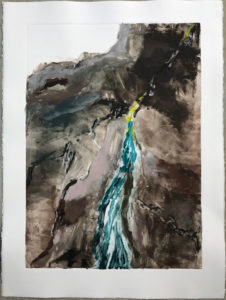
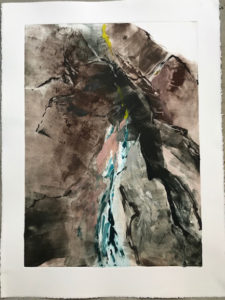 The journey of Moses leading the Hebrews out of slavery and into the land has informed some recent visual work. There’s a curious episode with water coming out of a rock that strangely happens twice:
The journey of Moses leading the Hebrews out of slavery and into the land has informed some recent visual work. There’s a curious episode with water coming out of a rock that strangely happens twice:  But then, I noticed a diminutive collage, chosen as a favorite by the museum staff, “Art to Stop Traffic: What Mercy Requires of Us”. The piece is only 5”x 3.5”. This submission is a poignant contrast, rendered from found images, paper, pen and pencil. The value and color contrast is immediately obvious, but peering closer one sees the uncomfortable juxtaposition of plastic expressions, skin color, garish lighting, things hidden and things exposed.
But then, I noticed a diminutive collage, chosen as a favorite by the museum staff, “Art to Stop Traffic: What Mercy Requires of Us”. The piece is only 5”x 3.5”. This submission is a poignant contrast, rendered from found images, paper, pen and pencil. The value and color contrast is immediately obvious, but peering closer one sees the uncomfortable juxtaposition of plastic expressions, skin color, garish lighting, things hidden and things exposed.